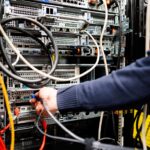
In the short-term Gartner® recommends baselining the current footprint of the IT organization – following the principles of the circular economy and GHG protocol. How important is this first step?
As humanity’s digital footprint grows faster than any other indicator, it is becoming urgent to accelerate the convergence between ecological awareness and digital growth. A more sustainable and responsible use of digital technology is possible. Yet “We can only improve what we can measure” Understanding the impact of the hardware lifecycle by looking at emissions, data center energy consumption and e-waste, is essential to calculate the carbon footprint. Gartner® recommends assessing all scope emissions, including scope 3, which reveals the impact of machinery used for raw material sourcing, manufacturing, and transportation. With a baseline established, companies gain an understanding of potential reductions and how to achieve them.
In the mid-term, Gartner® highlights setting targets and committing to measuring progress. What are some key targets they could identify?
Companies can assess energy consumption, including data center cooling systems, while evaluating raw material supply and material production. Considering transport emissions throughout the entire supply chain, and the energy efficiency and compliance of buildings and infrastructure also helps develop I&O targets. I&O leaders should also identify how an organization helps its clients to reduce carbon emissions by evaluating products and services. This includes assessing whether these products and services address customer needs and contribute to asset lifecycle extension. Regarding IT infrastructure, determining how long equipment has been in use helps I&O leaders set goals on how many years to prolong the lifespan of assets. The new legislations in Europe and the USA on Right to Repair are definitely a step in the right direction! Organizations can also calculate how much second-hand equipment and IT hardware is recycled and disposed of following WEEE standards.
‘Kickstarting a sustainable I&O strategy is often challenging due to a lack of guidance around where to start or what metrics to measure, as there does not yet exist any universally accepted framework for reporting on IT sustainability’ – can you give recommendations for initiatives or bodies that are starting to make headway in this space?
Soft laws, including the Basel Convention, the Stockholm Convention, and the ILO conventions are highlighting issues surrounding waste, pollution, and labor conditions. EU directives on battery use, as well as EcoDesign, RoHS, and WEEE, are also making an impact.
The Environmental Footprint further has a general methodology, known as the Product Environmental Footprint (PEF) and Organization Environmental Footprint (OEF), which uses Lifecycle Analysis standards to quantify environmental impacts alongside standardized environmental indicators. Yet, regulations and directives covering reuse and reconditioning, product passports, and mandatory technical inspections are not covered. For it to work, we need to scale the availability of spares and repair services locally, to ensure it is even possible to do so! The Right to Repair laws are a game changer in that account. For example, in France the AGEC law is imposing all public structures to purchase at least 20% of their IT equipment as second-hand. The private sector is listening and starting to move to in this direction.
Using advanced applications, organizations are now able to gauge that it is not always necessary to replace their hardware every 3 to 5 years to run critical operations Preventive maintenance and good care can make hardware last many years after the manufacturer End-of-Service-Life date. This is definitely something that should reconcile both CFOs and CIOs! Also, regulations could impose extra charges on the purchase of new electronic equipment to encourage even greater reuse rates, strengthen consumer control over software updates and extend legal guarantees for digital equipment. In France alone many sustainable IT organizations, including Evernex partners GreenIT and Planet Techcare, are voicing their concerns, offering expertise and lobbying the government and the EU regarding a range of sustainable IT issues.
How can companies improve employee engagement in I&O sustainability initiatives and why is this important?
Conducting maturity assessments within business units and across the entire organization shows where organizations stand on the sustainable IT agenda and where critical action is required. Assessments should include quantitative aspects, such as potential cost or carbon savings, and qualitative aspects, like employee behavioral impact and vendor assessments. Employee engagement is critical and there are many aspects that can be handled and decided upon at a collective and organizational level – sustainability is only achieved if everyone works together.
What are Evernex’s sustainability goals – has it defined targets to meet in the coming years and what’s the roadmap?
After updating our carbon footprint calculations in 2021, we found that as much as 96% of our emissions originate in our supply chain, from sourcing and delivering materials and shipping products to businesses. That’s why we’ve committed to implementing a low carbon strategy by joining a Carbon Disclosure Project (CDP) initiative called Assessing Low Carbon Transition (ACT), which uses a 3-year long methodology to support the development of a low-carbon strategy, helping us set GHG reduction targets, and establishing a decarbonization transition plan and roadmap.
This approach is based on the following international standards: CDP, SBTi, GRI, TCFD and ISO 14001. Our Environment ISO certifications also ensure all departments are taking the necessary steps to align our everyday business operations with a sustainable, circular IT future.
What could the long-term future of I&O look like if companies choose to partner with Evernex now?
Evernex’s goal is to help companies maximize the value of existing assets through cost effective solutions. Our services allow I&O teams to extend their IT budget and channel the extra revenue into investments that will drive business performance. Evernex also helps companies become part of a circular IT economy by reducing CO2 emissions caused by manufacturing and cutting down on harmful waste. By acting now, I&O leaders can stay ahead of future environmental regulations, stand out amongst their competitors, and take crucial steps towards a greener planet.




